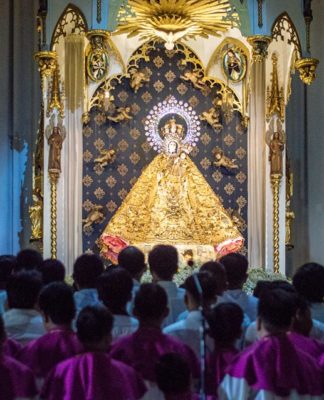IN A PENNILESS Christmas, one can’t help but look back at those years when “Christmas bonus” was significant amount. Hearing about scavenging families and drab forecasts for the coming year makes one feel like being in the Twilight Zone . While these scenarios seem too dreary, imagine what stories UST can tell of 60 years ago.
Think of UST with barbed wire around its walls, keeping 4000 people from escaping. It was the Japanese occupation. Foreign civilian prisoners housed here were dying of starvation, malaria, dysentery, dengue, and hepatitis. Underground literature on this bygone and bypassed era in the University’s history abound abroad, but there are almost none in the Philippines, even in UST.
How was life here back then? Not far from what you get at Smokey Mountain. Internees ate stray cats, leaves, banana skin, and animal slops from the Japanese pig pen. “If you found bugs in your food, that was extra,” Jim Faggiano recalls in the Teresa Brown chronicle, Surviving the Times.
Men and boys, women and girls were detained separately. But from their quarters, they could see a family member gorily beheaded or tortured. That was the order of the day from late 1942 to early 1945. Some internees would even rather commit suicide.
However improbable, there were light moments as recalled by camp nurse Hattie Brantley.
Since the Japanese had a tradition to exchange bows, one time, the ladies connived to pass through a gate in single file so the guard assigned would tire down bowing back to each of them. The next day, the guard shifted station and would turn his back on the women.
“My friends felt the same way I did, that if you don’t laugh, you’re going to lose your mind. It’s too much pain, all at once,” Margaret Gillooly writes in Prisoner of War. “The only thing you could do was pray. It was prayer that sustained me.”
Not to miss Christmas, the prisoners would spend their creative juices preparing Christmas cards, and in 1943, a 100-strong choral presentation of Handel’s Messiah. Unlike the Nazis, the Japanese were lenient with creative productions, which the prisoners secretly rehearsed on the camp roof.
The following year, they held a gala Christmas party, with bits of rice and reused ground coffee. Some already had their hopes down; their savior would come later still.
The Japanese scheduled to execute everyone in the camp on Feb. 4, 1945. A Japanese-American spy happened to read the notice and informed McArthur of it. Suddenly, American planes came like Santa’s sleighs, dropping leaflets with the note: “Hang on. Your Christmas is coming soon.” A pair of goggles was tossed out with a memo: “Roll out the barrel. Christmas will be Saturday or Monday.”
As promised, McArthur’s 1st Cavalry entered UST the night before the scheduled holocaust. It was short of a miracle. The prisoners were screaming with joy, but the Japanese in the convent were, oddly, eating dinner, without hearing what was happening outside. They were caught unready.
“You know what a tank sounds like, there were two, and all these gunfire. It was a complete miracle that we heard it, but the Japanese inside couldn’t,” Gillooly wrote.
At last, on Feb. 7, McArthur officially announced the camp’s liberation from the marquee of the Main Building. The internees’ prayers were answered with a Christmas gift they would never forget. Christmas came to them after all, because they believed in it and made it happen. Stirring enough for us Filipinos, especially Thomasians, to take heart this bleak Yuletide.












